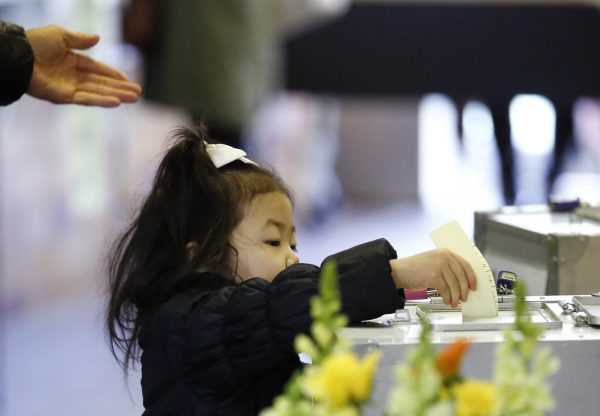The main difference from the last general election in 2014 was the pre-election split of the main opposition Democratic Party (DP) into two new parties — the Party of Hope and the Constitutional Democratic Party of Japan (CDPJ). The arrival of the new parties briefly led to speculation that Abe might have miscalculated by calling the snap election.
But did the advent of these new parties affect the outcome in any interesting ways?
Japan’s electoral system combines 289 single-member districts (SMDs) elected by plurality rule (the ‘first-past-the-post’ system) with 176 seats separately elected by closed-list proportional representation. The Party of Hope and the CDPJ combined won twice as many proportional representation seats in 2017 (69) as the Democratic Party of Japan — the precursor to the DP — won in 2014 (35). But this gain came at the expense of two parties that did moderately well in 2014 — Nippon Ishin no Kai (Ishin) and the Japan Communist Party. So, in the short run, the break-up of the DP mostly served to rearrange support among opposition parties.
One might expect that the DP split would have mattered more in the winner-take-all SMDs. This is not the case if we consider only the Party of Hope and CDPJ, as these parties only competed against each other in 39 SMDs. But how many SMDs might the LDP–Komeito coalition have surrendered against a more unified opposition, including former-DP independents and the smaller parties (assuming constant support and turnout of voters)? Of the LDP–Komeito coalition’s 223 SMD winners, 135 took more than half the vote. Opposition coordination would likely not have changed those outcomes. And it is hard to imagine successful opposition coordination in the other 88 districts since the opposition parties were divided along ideological lines: the CDPJ was formed by politicians who refused to pledge support for Party of Hope policy positions that resembled those of the LDP. But even ideological rivals might find common cause in fighting the LDP–Komeito coalition.
The LDP has always dominated rural Japan and 100 of the 135 unwinnable districts for the opposition were rural or mixed urban–rural. But in 59 of its 94 urban wins, the LDP–Komeito coalition winner fell short of 50 per cent. Could the opposition have taken some of those seats? Perfect coordination among the Party of Hope, the CDPJ, and Ishin might have denied the LDP–Komeito coalition up to 21 urban seats. If the full opposition (minus independents) could have found a way to agree on a single candidate in each district, the LDP and Komeito might have lost as many as 56 of the urban seats that it took in 2017.
In sum, the good news for the opposition is that better coordination in even a few urban SMDs would have blocked an LDP–Komeito supermajority. The bad news is that only near-perfect coordination (and voter mobilisation) would have denied LDP and Komeito a strict majority.
To win government, then, the opposition needs more than improved tactics — it needs to become more popular. In place of a fractious and aimless DP at the centre of a chaotic alliance, 2017 saw the opposition consolidate into two relatively coherent blocs: a neoliberal, hawkish bloc led by the Party of Hope and Ishin as well as a redistributionist, dovish group anchored by the CDPJ. Can either find a path to power?
The Party of Hope’s approach of mimicking most of the LDP–Komeito platform and hoping to win on valence appeals is unlikely to work unless living standards decline noticeably. Class warfare and pacifist idealism — pillars of the Japanese left — are less popular than ever and a trap the CDPJ would do well to avoid. On the other hand, recent opinion polls suggest that the CDPJ may be the only opposition party to come out of the election in a position to credibly challenge the ruling coalition in future elections.
The remaining approach is to find policy issues that can drive a wedge either between the LDP and Komeito, or within the LDP itself. The 1993 and 2005 LDP splits fell along a liberal/protectionist divide. This has analogues in the globalist/anti-globalist cleavage that is disrupting party systems across advanced democracies. The Democratic Party of Japan won in 2009 with calls not for a rejection of globalisation and liberalisation but for a stronger welfare state to compensate the losers. Despite the Democratic Party of Japan’s failed first attempt, this approach might be worth another try.
The 2017 election renewed the status quo. Any future challengers will have their best chance in the growing urban tranche of Diet seats. They must also find a way to exploit contradictions between the interests of the LDP’s rural voters and those in the cities, or between the LDP and Komeito. The opposition must also consider how to activate the near-half of the electorate who stayed home for Abe’s three landslide wins.
Ethan Scheiner is a professor in the Department of Political Science at the University of California, Davis, and co-editor of Japan Decides 2017: The Japanese General Election.
Daniel M Smith is an associate professor in the Department of Government at Harvard University, and co-editor of Japan Decides 2017: The Japanese General Election.
Michael F Thies is an associate professor in the Department of Political Science at the University of California, Los Angeles.

